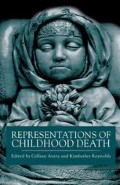Abstract
Books which include child deathbeds were enormously popular in the second half of the nineteenth century; they were also extremely varied. Through the mingling of spiritual, social and aesthetic discourses, literary representations of dead and dying children became multivalent signifiers. At times (for instance, in The Fairchild Family, 1818) they are inscribed with residual Calvinism and their deaths used to urge others (including readers) to piety; in the hands of evangelical writers, the dying child is not only an instrument of others’ salvation, but is also employed to provoke social reform. In works such as Hesba Stretton’s Little Meg’s Children (1868) or ‘Brenda’s’ Froggy’s Little Brother (1875), emphasis is not (as in many earlier works featuring the death of children) on triumphant death but on the causes of child death. Their purpose is to call attention to the social problems which result in children living hideous lives of cruelty and neglect which too often ended in early death.
It has been said that if anybody can get a pretty little girl to die prattling to her brothers and sisters, and quoting texts of Scripture with appropriate gasps, dashes, and broken sentences, he may send half the women in London, with tears in their eyes, to Mr. Mudie’s or Mr. Booth’s.
Francis Jacox, ‘About Goody Children’, Temple Bar August, 18681
Access this chapter
Tax calculation will be finalised at checkout
Purchases are for personal use only
Preview
Unable to display preview. Download preview PDF.
Notes
Quoted in L. Lerner, Angels and Absences: Child Deaths in the Nineteenth Century (Nashville and London: Vanderbilt University Press, 1997), p. 204.
Quoted in R. Ellman, Oscar Wilde (London: Penguin, 1988), p. 441.
See B. Dijkstra, Idols of Perversity: Fantasies of Feminine Evil in Fin-deSiècle Culture (New York and Oxford: Oxford University Press, 1986).
See J. Rose, The Case of Peter Pan, or, The Impossibility of Children’s Fiction (London: Macmillan, 1984).
M. Warner, From the Beast to the Blonde (London: Chatto & Windus, 1994), p. 349.
Editor information
Editors and Affiliations
Copyright information
© 2000 Palgrave Macmillan, a division of Macmillan Publishers Limited
About this chapter
Cite this chapter
Reynolds, K. (2000). Fatal Fantasies: the Death of Children in Victorian and Edwardian Fantasy Writing. In: Avery, G., Reynolds, K. (eds) Representations of Childhood Death. Palgrave Macmillan, London. https://doi.org/10.1007/978-1-349-62340-2_10
Download citation
DOI: https://doi.org/10.1007/978-1-349-62340-2_10
Publisher Name: Palgrave Macmillan, London
Print ISBN: 978-1-349-62342-6
Online ISBN: 978-1-349-62340-2
eBook Packages: Palgrave History CollectionHistory (R0)

